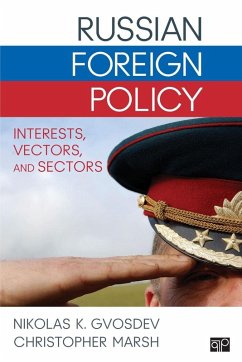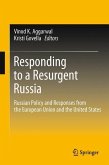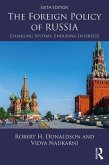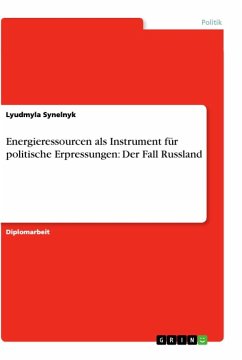- Broschiertes Buch
- Merkliste
- Auf die Merkliste
- Bewerten Bewerten
- Teilen
- Produkt teilen
- Produkterinnerung
- Produkterinnerung
In a truly contemporary analysis of Moscow's relations with its neighbours and other strategic international actors, Gvosdev and Marsh use a comprehensive vectors approach, dividing the world into eight geographic zones. Each vector chapter looks at the dynamics of key bilateral relationships while highlighting major topical issues - oil and energy, defence policy, economic policy, the role of international institutions, and the impact of major interest groups or influencers - demonstrating that Russia formulates multiple, sometimes contrasting, foreign policies. Providing rich historical…mehr
Andere Kunden interessierten sich auch für
![Russland, der Energiechartavertrag und die EU Russland, der Energiechartavertrag und die EU]() Steffi WilkeRussland, der Energiechartavertrag und die EU48,00 €
Steffi WilkeRussland, der Energiechartavertrag und die EU48,00 €![Responding to a Resurgent Russia Responding to a Resurgent Russia]() Responding to a Resurgent Russia75,99 €
Responding to a Resurgent Russia75,99 €![Russlands Außenpolitik Russlands Außenpolitik]() Christian WipperfürthRusslands Außenpolitik27,99 €
Christian WipperfürthRusslands Außenpolitik27,99 €![The Foreign Policy of Russia The Foreign Policy of Russia]() Vidya NadkarniThe Foreign Policy of Russia50,99 €
Vidya NadkarniThe Foreign Policy of Russia50,99 €![The Foreign Policy of Russia The Foreign Policy of Russia]() Robert H DonaldsonThe Foreign Policy of Russia240,99 €
Robert H DonaldsonThe Foreign Policy of Russia240,99 €![U.S. Foreign Policy in Perspective U.S. Foreign Policy in Perspective]() David SylvanU.S. Foreign Policy in Perspective72,99 €
David SylvanU.S. Foreign Policy in Perspective72,99 €![Energieressourcen als Instrument für politische Erpressungen: Der Fall Russland Energieressourcen als Instrument für politische Erpressungen: Der Fall Russland]() Lyudmyla SynelnykEnergieressourcen als Instrument für politische Erpressungen: Der Fall Russland47,95 €
Lyudmyla SynelnykEnergieressourcen als Instrument für politische Erpressungen: Der Fall Russland47,95 €-
-
-
In a truly contemporary analysis of Moscow's relations with its neighbours and other strategic international actors, Gvosdev and Marsh use a comprehensive vectors approach, dividing the world into eight geographic zones. Each vector chapter looks at the dynamics of key bilateral relationships while highlighting major topical issues - oil and energy, defence policy, economic policy, the role of international institutions, and the impact of major interest groups or influencers - demonstrating that Russia formulates multiple, sometimes contrasting, foreign policies. Providing rich historical context as well as exposure to the scholarly literature, the authors offer an incisive look at how and why Russia partners with some states while it counter-balances others.
Hinweis: Dieser Artikel kann nur an eine deutsche Lieferadresse ausgeliefert werden.
Hinweis: Dieser Artikel kann nur an eine deutsche Lieferadresse ausgeliefert werden.
Produktdetails
- Produktdetails
- Verlag: Sage Publications
- Artikelnr. des Verlages: 56134343
- Seitenzahl: 456
- Erscheinungstermin: 4. September 2013
- Englisch
- Abmessung: 229mm x 152mm x 24mm
- Gewicht: 598g
- ISBN-13: 9781452234847
- ISBN-10: 1452234841
- Artikelnr.: 39764087
- Herstellerkennzeichnung
- Libri GmbH
- Europaallee 1
- 36244 Bad Hersfeld
- gpsr@libri.de
- Verlag: Sage Publications
- Artikelnr. des Verlages: 56134343
- Seitenzahl: 456
- Erscheinungstermin: 4. September 2013
- Englisch
- Abmessung: 229mm x 152mm x 24mm
- Gewicht: 598g
- ISBN-13: 9781452234847
- ISBN-10: 1452234841
- Artikelnr.: 39764087
- Herstellerkennzeichnung
- Libri GmbH
- Europaallee 1
- 36244 Bad Hersfeld
- gpsr@libri.de
Nikolas K. Gvosdev (PhD, St. Antony¿s College, Oxford University) is professor of national security studies at the U.S. Naval War College, a senior editor at The National Interest, and a frequent commentator on U.S. foreign policy and international relations, Russian and Eurasian affairs, developments in the Middle East, and the role of religion in politics. The co-author of The Receding Shadow of the Prophet: The Rise and Fall of Political Islam, Gvosdev has published over 50 articles, columns, and essays on democratization and human rights; general foreign policy; energy policy; foreign policy of Russia and the Eurasian states; U.S. foreign policy and the Middle East; politics and culture of the Eurasian states; and religion and politics. His work has appeared in Foreign Affairs, The Financial Times, The Los Angeles Times, National Review, Religion State and Society, The National Interest, Orbis, The Washington Quarterly, Problems of Post-Communism, and World Policy Journal.
List of Tables, Figures, and Map
Principal Vectors in Russian Foreign Policy
Preface
Acknowledgments
About the Editors
Introduction
The Challenges Facing Russia
1. The Historical Legacy for Contemporary Russian Foreign Policy
The Soviet Legacy
2. Vectors and Sectors: The Russian Foreign Policy Mechanism
The Constitutional Structure: President and Prime Minister
Searching for a Role: The Legislature
The Position of the Foreign Ministry: One Actor Among Many
The Regional Governments
The State Companies and Private Business
The Nongovernmental Organizations
Russian National Security Decision Making
The Principal Vectors
3. The United States: The Main Enemy or Strategic Partner?
Legacy of the Cold War
Gorbachev: The Search for Condominium
The Yeltsin Era and "Tainted Transactions"
Putin-Bush and Obama-Medvedev: Soul Connections?
Some Enduring Obstacles
Institutionalizing the Relationship
The Balance Sheet
4. The Bear and the Dragon: China and the East Asia Vector
Triangular Relations: Opportunities and Challenges
The Dragon Turns to the Bear
The Bear Embraces the Dragon
The Bear Arms the Dragon
An Emerging Strategic Alliance?
Mending Fences: Russia-Japan Relations
Korea: Unparalleled Relations
Vietnam: Moscow's Toehold in Southeast Asia
Setting Its Eyes on Asia
5. The Eurasian Space
The Disintegration of the Soviet Union
The Eurasian Vision
Breaking Up Is Hard To Do
The Frozen Conflicts
The Georgia-Russia War and Its Aftermath
The Ties That Bind
Securing Eurasia
A Eurasian Convergence Zone?
The Eurasian Union: USSR Lite?
Euraskepticism
Putin's Eurasian Dream
6. Eastern Europe: Comrades no More
The Second World War and the Creation of the Soviet Bloc
1989-1999: The Attempt to Preserve Eastern Europe
The Baltics and Beyond: NATO's Reach East
Baltic [In]Security
From Tragedy to Reconciliation? Developments in Russia-Poland Relations
Russian Impotence in the Balkans
Moscow's "Ruble Diplomacy" and Russia's Return to Eastern Europe
7. Europe: Russia's "Traditional Orientation"
Russia and the European Union Since the Soviet Collapse
The Russo-German Relationship
The Russian Relationship with France
The Overlooked Partnership: Italy and Russia
The Bulldog and the Bear: Russia and Great Britain
Other Relationships
The Arctic Dimension
Concluding Thoughts
8. The Near-Eastern Vector
Russia-Turkey: The Unexpected Partnership
Israel: "Practically a Russian-Speaking Country"?
Russia-Saudi Arabia: The Start of a Rapprochement?
Traditional Arab Partners
Moscow's Traditional Ally Syria
The Transformation of Russian-Iranian Relations
Overall Conclusion
9. Call Across the Himalayas: The South Asia Vector
The Immediate Post-Soviet Policy
The Failed Rapprochement with Pakistan?
The Model Partnership: India
The Russia-India-China Troika
Drivers of the Indo-Russian Entente
10. Africa and Latin America: The Southern Vector
The Return to Africa
Latin America Beckons
Building the BRICS
11. Epilogue
Index
Principal Vectors in Russian Foreign Policy
Preface
Acknowledgments
About the Editors
Introduction
The Challenges Facing Russia
1. The Historical Legacy for Contemporary Russian Foreign Policy
The Soviet Legacy
2. Vectors and Sectors: The Russian Foreign Policy Mechanism
The Constitutional Structure: President and Prime Minister
Searching for a Role: The Legislature
The Position of the Foreign Ministry: One Actor Among Many
The Regional Governments
The State Companies and Private Business
The Nongovernmental Organizations
Russian National Security Decision Making
The Principal Vectors
3. The United States: The Main Enemy or Strategic Partner?
Legacy of the Cold War
Gorbachev: The Search for Condominium
The Yeltsin Era and "Tainted Transactions"
Putin-Bush and Obama-Medvedev: Soul Connections?
Some Enduring Obstacles
Institutionalizing the Relationship
The Balance Sheet
4. The Bear and the Dragon: China and the East Asia Vector
Triangular Relations: Opportunities and Challenges
The Dragon Turns to the Bear
The Bear Embraces the Dragon
The Bear Arms the Dragon
An Emerging Strategic Alliance?
Mending Fences: Russia-Japan Relations
Korea: Unparalleled Relations
Vietnam: Moscow's Toehold in Southeast Asia
Setting Its Eyes on Asia
5. The Eurasian Space
The Disintegration of the Soviet Union
The Eurasian Vision
Breaking Up Is Hard To Do
The Frozen Conflicts
The Georgia-Russia War and Its Aftermath
The Ties That Bind
Securing Eurasia
A Eurasian Convergence Zone?
The Eurasian Union: USSR Lite?
Euraskepticism
Putin's Eurasian Dream
6. Eastern Europe: Comrades no More
The Second World War and the Creation of the Soviet Bloc
1989-1999: The Attempt to Preserve Eastern Europe
The Baltics and Beyond: NATO's Reach East
Baltic [In]Security
From Tragedy to Reconciliation? Developments in Russia-Poland Relations
Russian Impotence in the Balkans
Moscow's "Ruble Diplomacy" and Russia's Return to Eastern Europe
7. Europe: Russia's "Traditional Orientation"
Russia and the European Union Since the Soviet Collapse
The Russo-German Relationship
The Russian Relationship with France
The Overlooked Partnership: Italy and Russia
The Bulldog and the Bear: Russia and Great Britain
Other Relationships
The Arctic Dimension
Concluding Thoughts
8. The Near-Eastern Vector
Russia-Turkey: The Unexpected Partnership
Israel: "Practically a Russian-Speaking Country"?
Russia-Saudi Arabia: The Start of a Rapprochement?
Traditional Arab Partners
Moscow's Traditional Ally Syria
The Transformation of Russian-Iranian Relations
Overall Conclusion
9. Call Across the Himalayas: The South Asia Vector
The Immediate Post-Soviet Policy
The Failed Rapprochement with Pakistan?
The Model Partnership: India
The Russia-India-China Troika
Drivers of the Indo-Russian Entente
10. Africa and Latin America: The Southern Vector
The Return to Africa
Latin America Beckons
Building the BRICS
11. Epilogue
Index
List of Tables, Figures, and Map
Principal Vectors in Russian Foreign Policy
Preface
Acknowledgments
About the Editors
Introduction
The Challenges Facing Russia
1. The Historical Legacy for Contemporary Russian Foreign Policy
The Soviet Legacy
2. Vectors and Sectors: The Russian Foreign Policy Mechanism
The Constitutional Structure: President and Prime Minister
Searching for a Role: The Legislature
The Position of the Foreign Ministry: One Actor Among Many
The Regional Governments
The State Companies and Private Business
The Nongovernmental Organizations
Russian National Security Decision Making
The Principal Vectors
3. The United States: The Main Enemy or Strategic Partner?
Legacy of the Cold War
Gorbachev: The Search for Condominium
The Yeltsin Era and "Tainted Transactions"
Putin-Bush and Obama-Medvedev: Soul Connections?
Some Enduring Obstacles
Institutionalizing the Relationship
The Balance Sheet
4. The Bear and the Dragon: China and the East Asia Vector
Triangular Relations: Opportunities and Challenges
The Dragon Turns to the Bear
The Bear Embraces the Dragon
The Bear Arms the Dragon
An Emerging Strategic Alliance?
Mending Fences: Russia-Japan Relations
Korea: Unparalleled Relations
Vietnam: Moscow's Toehold in Southeast Asia
Setting Its Eyes on Asia
5. The Eurasian Space
The Disintegration of the Soviet Union
The Eurasian Vision
Breaking Up Is Hard To Do
The Frozen Conflicts
The Georgia-Russia War and Its Aftermath
The Ties That Bind
Securing Eurasia
A Eurasian Convergence Zone?
The Eurasian Union: USSR Lite?
Euraskepticism
Putin's Eurasian Dream
6. Eastern Europe: Comrades no More
The Second World War and the Creation of the Soviet Bloc
1989-1999: The Attempt to Preserve Eastern Europe
The Baltics and Beyond: NATO's Reach East
Baltic [In]Security
From Tragedy to Reconciliation? Developments in Russia-Poland Relations
Russian Impotence in the Balkans
Moscow's "Ruble Diplomacy" and Russia's Return to Eastern Europe
7. Europe: Russia's "Traditional Orientation"
Russia and the European Union Since the Soviet Collapse
The Russo-German Relationship
The Russian Relationship with France
The Overlooked Partnership: Italy and Russia
The Bulldog and the Bear: Russia and Great Britain
Other Relationships
The Arctic Dimension
Concluding Thoughts
8. The Near-Eastern Vector
Russia-Turkey: The Unexpected Partnership
Israel: "Practically a Russian-Speaking Country"?
Russia-Saudi Arabia: The Start of a Rapprochement?
Traditional Arab Partners
Moscow's Traditional Ally Syria
The Transformation of Russian-Iranian Relations
Overall Conclusion
9. Call Across the Himalayas: The South Asia Vector
The Immediate Post-Soviet Policy
The Failed Rapprochement with Pakistan?
The Model Partnership: India
The Russia-India-China Troika
Drivers of the Indo-Russian Entente
10. Africa and Latin America: The Southern Vector
The Return to Africa
Latin America Beckons
Building the BRICS
11. Epilogue
Index
Principal Vectors in Russian Foreign Policy
Preface
Acknowledgments
About the Editors
Introduction
The Challenges Facing Russia
1. The Historical Legacy for Contemporary Russian Foreign Policy
The Soviet Legacy
2. Vectors and Sectors: The Russian Foreign Policy Mechanism
The Constitutional Structure: President and Prime Minister
Searching for a Role: The Legislature
The Position of the Foreign Ministry: One Actor Among Many
The Regional Governments
The State Companies and Private Business
The Nongovernmental Organizations
Russian National Security Decision Making
The Principal Vectors
3. The United States: The Main Enemy or Strategic Partner?
Legacy of the Cold War
Gorbachev: The Search for Condominium
The Yeltsin Era and "Tainted Transactions"
Putin-Bush and Obama-Medvedev: Soul Connections?
Some Enduring Obstacles
Institutionalizing the Relationship
The Balance Sheet
4. The Bear and the Dragon: China and the East Asia Vector
Triangular Relations: Opportunities and Challenges
The Dragon Turns to the Bear
The Bear Embraces the Dragon
The Bear Arms the Dragon
An Emerging Strategic Alliance?
Mending Fences: Russia-Japan Relations
Korea: Unparalleled Relations
Vietnam: Moscow's Toehold in Southeast Asia
Setting Its Eyes on Asia
5. The Eurasian Space
The Disintegration of the Soviet Union
The Eurasian Vision
Breaking Up Is Hard To Do
The Frozen Conflicts
The Georgia-Russia War and Its Aftermath
The Ties That Bind
Securing Eurasia
A Eurasian Convergence Zone?
The Eurasian Union: USSR Lite?
Euraskepticism
Putin's Eurasian Dream
6. Eastern Europe: Comrades no More
The Second World War and the Creation of the Soviet Bloc
1989-1999: The Attempt to Preserve Eastern Europe
The Baltics and Beyond: NATO's Reach East
Baltic [In]Security
From Tragedy to Reconciliation? Developments in Russia-Poland Relations
Russian Impotence in the Balkans
Moscow's "Ruble Diplomacy" and Russia's Return to Eastern Europe
7. Europe: Russia's "Traditional Orientation"
Russia and the European Union Since the Soviet Collapse
The Russo-German Relationship
The Russian Relationship with France
The Overlooked Partnership: Italy and Russia
The Bulldog and the Bear: Russia and Great Britain
Other Relationships
The Arctic Dimension
Concluding Thoughts
8. The Near-Eastern Vector
Russia-Turkey: The Unexpected Partnership
Israel: "Practically a Russian-Speaking Country"?
Russia-Saudi Arabia: The Start of a Rapprochement?
Traditional Arab Partners
Moscow's Traditional Ally Syria
The Transformation of Russian-Iranian Relations
Overall Conclusion
9. Call Across the Himalayas: The South Asia Vector
The Immediate Post-Soviet Policy
The Failed Rapprochement with Pakistan?
The Model Partnership: India
The Russia-India-China Troika
Drivers of the Indo-Russian Entente
10. Africa and Latin America: The Southern Vector
The Return to Africa
Latin America Beckons
Building the BRICS
11. Epilogue
Index









